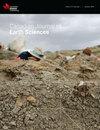The mid-Cretaceous Peninsular Ranges orogeny: a new slant on Cordilleran tectonics? III: The orogenic foredeep
IF 1.6
4区 地球科学
Q3 GEOSCIENCES, MULTIDISCIPLINARY
引用次数: 2
Abstract
The Cretaceous Western Interior Basin reflects the interplay between the North American craton and allochthonous terranes to the west. We divide the basinal stratigraphy into three successions, Aptian-Albian, Cenomanian-Turonian, and Santonian-Maastrichtian, each related to periods of deformation in the adjacent fold-thrust belt. Here we focus on the Cenomanian-Turonian succession, where progressive west to east uplift and fluvial incision of older Aptian-Albian sedimentary rocks (Cedar Mtn-San Pitch-Thermopolis-Skull Creek-Mannville) are interpreted as a migrating forebulge. Uplift was underway at 103 Ma in the west (Paddy-Blackleaf-Muddy sandstones) and propagated eastward throughout the trough by 99.5 Ma (Viking-Bow Island-Newcastle sandstones). The incised fluvial valleys were subsequently filled by swampy and shallow marine facies, then overlain by dark, marine Neogastroplites-bearing shale and associated bentonites of the 100-97.5 Ma Shell Creek-Mowry-Slater River-Goodrich-Shaftesbury-Westgate shales. The shales are characterized by a distinctive condensed horizon with abundant fish scales, teeth, and bones. They are interpreted as outer-trench slope deposits, with the overlying anoxic horizon representing a starved isochronous unit formed atop the slope deposits. The starved horizon is overlain by prodeltaic muddy clinoforms of easterly migrating clastic wedges (Trevor-Dunvegan-Frontier-Cintura-Mexcala) that can be traced 800 km atop the fish-scale hash and contain hinterland-derived 99-90 Ma detrital zircons. Although the Western Interior Basin has long been considered a retro-arc trough, the overall succession instead suggests that the Cretaceous-Turonian part represents a collisional foredeep created during the ~100 Ma collision between the arc-bearing Peninsular Ranges composite terrane and North America. The accretion brought tyrannosaurids, pachycephalosaurs, snakes and marsupials to North America.中白垩世半岛山脉造山运动:科迪勒拉构造的新视角?造山带前深
白垩纪西部内陆盆地反映了北美克拉通与西部异域地体的相互作用。将盆地地层划分为阿普梯—阿尔梯、塞诺曼梯—图尔梯和圣东梯—马斯特里赫特3个序列,每个序列与相邻褶皱冲断带的变形期有关。这里我们关注的是Cenomanian-Turonian演替,其中较老的Aptian-Albian沉积岩(Cedar mtnn - san Pitch-Thermopolis-Skull Creek-Mannville)的西向东递进隆起和河流切割被解释为迁移前隆起。西部103ma (paddy - blackleafy - muddy砂岩)抬升,东部99.5 Ma (Viking-Bow Island-Newcastle砂岩)抬升。切割的河流山谷随后被沼泽和浅海相填满,然后被100-97.5 Ma的贝壳溪-莫里-斯莱特河-古德里奇-沙夫茨伯里-韦斯特盖特页岩的暗色海相新胃长岩页岩和伴生的斑长岩覆盖。页岩的特点是一个独特的浓缩层,有丰富的鱼鳞、牙齿和骨头。它们被解释为沟外斜坡沉积物,上覆的缺氧层代表在斜坡沉积物上形成的饥饿等时单元。贫水层上覆盖着前三角洲泥质斜形,由东移的碎屑楔块(特雷弗-邓维根-前沿-辛图拉-梅卡拉)组成,在鱼鳞砾岩顶部可追溯800公里,含有来自内陆的99-90 Ma碎屑锆石。尽管西部内陆盆地长期以来一直被认为是一个弧后槽,但整体序列表明,白垩纪- turonian部分是在含弧的半岛山脉复合地体与北美碰撞~100 Ma期间形成的碰撞前深。这次增生把暴龙、厚头龙、蛇和有袋动物带到了北美。
本文章由计算机程序翻译,如有差异,请以英文原文为准。
求助全文
约1分钟内获得全文
求助全文
来源期刊

Canadian Journal of Earth Sciences
地学-地球科学综合
CiteScore
2.80
自引率
7.10%
发文量
66
审稿时长
6-12 weeks
期刊介绍:
The Canadian Journal of Earth Sciences reports current research in climate and environmental geoscience; geoarchaeology and forensic geoscience; geochronology and geochemistry; geophysics; GIS and geomatics; hydrology; mineralogy and petrology; mining and engineering geology; ore deposits and economic geology; paleontology, petroleum geology and basin analysis; physical geography and Quaternary geoscience; planetary geoscience; sedimentology and stratigraphy; soil sciences; and structural geology and tectonics. It also publishes special issues that focus on information and studies about a particular segment of earth sciences.
 求助内容:
求助内容: 应助结果提醒方式:
应助结果提醒方式:


